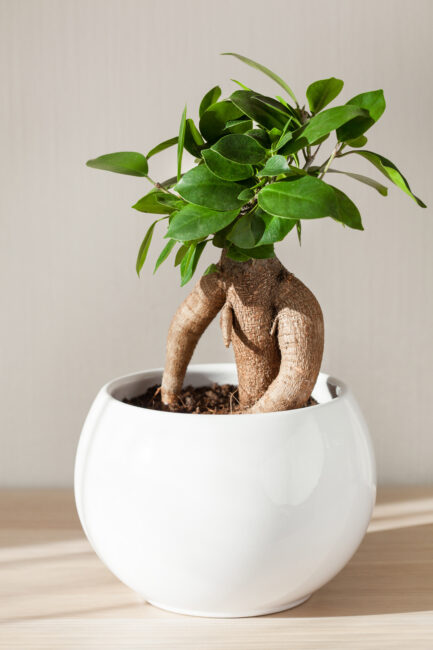Ficus Microcarpa , commonly known as small-leaf ficus, is a tree that captivates with its majesty and elegance. Native to Asia and Australia, this gentle giant has gracefully adapted to different environments, earning a place in gardens around the world.
Origin and Distribution
This evergreen tree has its roots in the warm Asian and Australian climate, where its presence is as common as it is impressive. The adaptability of the Ficus Microcarpa has allowed it to disperse globally, being found today in subtropical and temperate areas of the planet.
Distinctive features
The leaves of the Ficus Microcarpa are small, deep green, and create a dense canopy that provides deep, cooling shade. Its robust trunk and aerial roots, which often intertwine to form whimsical figures, add an air of mystery and antiquity.
How to Care for Your Ficus Microcarpa
The Ficus Microcarpa , a robust and beautiful tree, is a popular choice for those who want to add a touch of green to their surroundings. Although its maintenance is not particularly complicated, it requires specific attention and care to thrive. Here we offer you a detailed guide to keep your Ficus Microcarpa healthy and vigorous.
Light and Temperature Requirements
The Ficus Microcarpa prefers bright, indirect light. While it can tolerate some shade, lack of sufficient light can cause its leaves to drop. Place it near a window where it can receive natural light, but avoid direct sun exposure, especially during the brightest hours of the day. This tree enjoys warm temperatures, between 18°C and 24°C, and does not resist sudden changes in temperature or cold air currents well.
Irrigation and Humidity
Proper watering is crucial for Ficus Microcarpa. The soil should be kept moist, but not saturated. During the warmer months, it will likely need more frequent watering, while in winter, the frequency should be reduced. Make sure the water drains properly to avoid waterlogging, as this can lead to root rot.
Humidity also plays an important role in caring for this tree. It appreciates a humid environment, so spraying its leaves regularly with water can be beneficial, especially in dry environments or during the winter when the heating is on.
Pruning and Maintenance
Pruning is essential to maintain the desired shape of your Ficus Microcarpa and encourage healthy growth. Prune dead or damaged branches and any excess growth to maintain their size and shape. The best time to prune is in late winter or early spring, before new growth begins.
In addition to pruning, regularly wiping the leaves with a damp cloth will help remove dust and possible parasites, allowing the plant to breathe better and absorb more light.
Solutions to Common Problems
If you notice that the leaves of your Ficus Microcarpa turn yellow or fall, it could be due to excessive watering, lack of light or cold drafts. Adjust watering, check the location of the plant and make sure it is not exposed to extreme temperatures.
Detect pests such as mites or mealybugs, treat the infestations with an appropriate insecticide or home remedies, such as a soap and water solution.
Caring for a Ficus Microcarpa is a rewarding task that will not only beautify your space but will also give you the satisfaction of watching this magnificent tree grow and thrive. With proper care, your Ficus Microcarpa will become a source of joy and serenity for your home or garden.
Common Problems and Solutions
Despite its resistance, the Ficus Microcarpa is not free from pests and diseases. Early detection and proper treatment are key to protecting the health of your tree.
The Ficus Microcarpa in Garden Design
Its unique structure makes Ficus Microcarpa a popular choice in garden design. It can be the center of attention or be part of a larger composition with other plants.
Propagate Ficus Microcarpa
Propagation by cuttings is one of the fastest and most efficient methods to multiply your Ficus Microcarpa. Follow these steps:
by cuttings
- Selection of Cuttings : Choose a healthy cutting approximately 10-15 cm long, preferably with several leaves and that is neither too tender nor too woody.
- Cutting : Use sterilized pruning shears to make a clean cut just below a node (the point where the leaf joins the stem). This is important because it is at the nodes where root growth takes place.
- Preparation : Remove the leaves from the bottom of the cutting, leaving only a few at the top. This reduces water loss and allows the cutting to focus on root development.
- Rooting : You can choose to root the cutting in water or soil. To propagate in water, place the cutting in a glass with enough water to cover the bottom nodes. Change the water every few days to keep it clean . If you prefer to root in soil, plant the cutting in a well-drained potting soil mix, keeping it moist but not saturated.
- Post-planting Care : Place the cutting in a warm place with indirect light and wait. If you chose the water method, transplant into soil once the roots are a few inches long. This process may take several weeks.
By Seeds
Propagation by seeds is less common but equally viable for Ficus Microcarpa. It is a slower process that offers the satisfaction of watching a tree grow from the beginning.
- Obtaining Seeds : You can buy seeds or collect them from an adult tree. If you collect your own seeds, make sure they are ripe.
- Sowing : Plant the seeds in a germination tray or small pots with good quality potting soil. The seeds should be barely covered by soil.
- Germination : Keep the soil constantly moist, but not waterlogged. Place the tray or pot in a warm location with indirect light. Covering with plastic can help maintain moisture.
- Seedling Care : Once the seedlings emerge, remove the plastic if you are using it and continue caring for them in a warm location with good light. When the young plants are a manageable size and have developed several leaves, you can transplant them to larger pots or their final location.
Tips for Success
- Patience is key in the propagation of Ficus Microcarpa. Both rooting cuttings and germinating seeds take time.
- Maintain ideal humidity, temperature and light conditions to encourage growth.
- Use rooting hormones to increase the chances of success with cuttings, applying them to the cutting before planting.
Propagating your Ficus Microcarpa is a wonderful way to expand your plant collection or share this unique species with friends and family. With care and attention, you can enjoy the process of watching new trees grow from scratch.
Ficus microcarpa care
How do you care for a ficus microcarpa?
To care for a Ficus Microcarpa, follow these basic tips:
- 1 Light : Prefers bright, indirect light. Avoid direct exposure to the sun, which can burn its leaves.
- 2 Watering : Keep the soil moist, but not waterlogged. In winter, reduce the frequency of watering.
- 3 Humidity : Appreciates environments with moderate humidity. Spray its leaves regularly or use a humidifier.
- 4 Pruning : Prune regularly to maintain its shape and promote healthy growth. Remove yellow or damaged leaves.
- 5 Location : Place it in a place where it will not be exposed to cold air currents or sudden changes in temperature.
How much sun does a ficus need?
A ficus needs a lot of light, but not direct sun. Bright, indirect light is ideal. If it does not receive enough light, its leaves may fall or lose color. In case of direct sunlight, especially during the strongest hours of the day, its leaves can burn.
Where to put the ficus?
The ideal place for a ficus is near a window that receives natural light during the day, but without the sun’s rays falling directly on the plant. It must be protected from drafts and sudden changes in temperature, so avoid placing it near doors that frequently open to the outside or directly under or near air conditioners and heaters.
What climate does ficus need?
The ficus thrives in warm, humid climates, similar to its natural habitat in tropical and subtropical rainforests. Prefers consistent temperatures between 18°C and 24°C. It does not tolerate cold well, so temperatures below 10°C can damage it. If you live in an area with cold winters, it is crucial to keep him indoors during the colder months and ensure his environment maintains adequate relative humidity.
Bonsai Ficus Microcarpa: Miniaturized Beauty
The Ficus Microcarpa, with its thick trunk and aerial roots, is an ideal species for the art of bonsai. Adapted to life in small containers, this tree can live for many years with proper care, offering a miniature representation of the majesty of mature trees in the wild. Below I offer you a guide on how to care for and grow a Ficus Microcarpa bonsai.
Growing Conditions
- Location: Ficus Microcarpa bonsai thrive in well-lit environments, preferring indirect or filtered light. Although they are tolerant of low light levels, lack of enough light can weaken the plant. During the warmer months, consider placing your bonsai outdoors in a shady location to strengthen it.
- Irrigation: Irrigation should be adjusted to the specific needs of the bonsai, taking into account the season of the year, the location and the size of the container. The general rule is to water when the top layer of the substrate begins to dry, but without letting it dry completely. Avoid overwatering, as this can lead to root rot.

- The humidity: The Ficus Microcarpa appreciates environmental humidity. To increase humidity, you can place the pot on a tray with pebbles and water, making sure the bottom of the pot is not in direct contact with the water. This will help create a more humid environment around your bonsai, especially indoors.
- Fertilizing: Fertilize your Ficus Microcarpa bonsai regularly during the growing season (spring-summer), using a specific bonsai fertilizer or a generic one diluted to half the recommended strength. In autumn and winter, reduce the frequency of fertilization.
Pruning and Training
Pruning is essential to maintain the shape of the bonsai and stimulate the growth of new branches. Prune long or straggly branches during the growing season to maintain the desired shape. Root pruning is typically done during transplanting, every two to three years, to prevent the tree from becoming too large for its container.
Conclusion
Detailed summary table on the Ficus Microcarpa, covering key aspects, details, pros and cons, among other relevant data:
| Aspect | Details | Pros | Contras |
|---|---|---|---|
| Light | Prefers bright indirect light but can tolerate some shade. Avoid the direct exposure to the sun. | Adapts well to various levels of indoor lighting, ideal for homes and offices. | Lack of adequate light can lead to leaf drop. |
| Irrigation | It needs moderate watering. The soil must allow good drainage. Reduce watering in winter. | It tolerates brief periods of drought well, which makes it resilient to occasional forgetfulness. | Overwatering can cause root rot. |
| Humidity | It prefers environments with high humidity, although it adapts to lower levels. | Its preference for humidity helps improve indoor air quality. | In very dry environments, it may require frequent misting or a humidifier. |
Temperature |
Ideal between 18°C and 24°C. It does not tolerate cold or drafts well. | Its temperature range makes it suitable for most indoor environments. | Sensitive to sudden changes in temperature, which may limit its placement in some homes. |
| Pruning and Maintenance | Requires regular pruning to maintain shape and promote healthy growth. | Pruning allows it to adapt to specific spaces and designs, being versatile in decoration. | It requires constant maintenance to maintain its aesthetic shape. |
| Spread | It is easily propagated by cuttings, which allows the plant to be multiplied at no additional cost. | Easy to propagate, making it ideal for sharing or expanding personal collection. | Cuttings require specific care and conditions to root correctly. |
| Plagues and diseases | Susceptible to pests such as mites, mealybugs and whiteflies, as well as root rot due to excess water. | With proper care, it is quite hardy and can recover well from infestations. | It requires monitoring and timely treatment to prevent serious damage. |
Adaptability |
Very adaptable to different indoor conditions, capable of growing in various types of soil and light conditions. | Its high adaptability makes it ideal for beginners or for those who are not always at home. | It can become invasive under optimal outdoor conditions, although this is rarely a problem indoors. |
| Environmental impact | Improves indoor air quality and can help reduce stress. | Environmental and health benefits for homes and offices. | It requires resources such as water, fertilizers and possibly pesticides, which has an environmental impact. |
| Aesthetics | It offers a strong visual impact with its thick trunk and dense foliage. | Adds a sophisticated and natural element to any space. | May require relocation as it grows due to its size. |
Faqs: Ficus Microcarpa
Is the Ficus Microcarpa easy to care for?
Yes, the Ficus Microcarpa is relatively easy to care for, making it ideal for both beginner and experienced gardeners . It prefers environments with bright indirect light, regular watering that keeps its soil moist but not saturated, and warm temperatures.
¿ How much light does a Ficus Microcarpa need?
This ficus thrives in bright indirect light conditions. Although it can tolerate low light levels, lack of adequate light can cause it to lose leaves. Avoid direct sunlight, which can burn its leaves.
Type of fertilizer does Ficus Microcarpa need
During the growing season (spring and summer), fertilize the Ficus Microcarpa once a month with a balanced liquid fertilizer. In autumn and winter, reduce fertilization to once every two months.
Is Ficus Microcarpa toxic to pets?
Yes, Ficus Microcarpa can be toxic if ingested, causing mouth, skin and stomach irritation in pets and sometimes humans. It is advisable to keep it out of the reach of pets and small children.
How do you prune a Ficus Microcarpa?
Prune the Ficus Microcarpa to maintain its desired shape and size. Pruning can be done at any time of the year, but it is best to do it in spring or summer. Use clean pruning shears to cut off unwanted branches or to shape the plant.
What do I do if the leaves of my Ficus Microcarpa turn yellow and fall?
Falling and yellowing leaves can be caused by several factors, such as over- or under-watering, lack of light or cold drafts. Adjust care as needed and make sure the plant is not exposed to drastic changes in temperature or drafts.
Is it normal for the Ficus Microcarpa to lose some leaves?
Yes, it is normal for the Ficus Microcarpa to occasionally lose some leaves, especially when it adapts to a new environment. However, if leaf loss is excessive, review care conditions, such as light, watering, and temperature.
